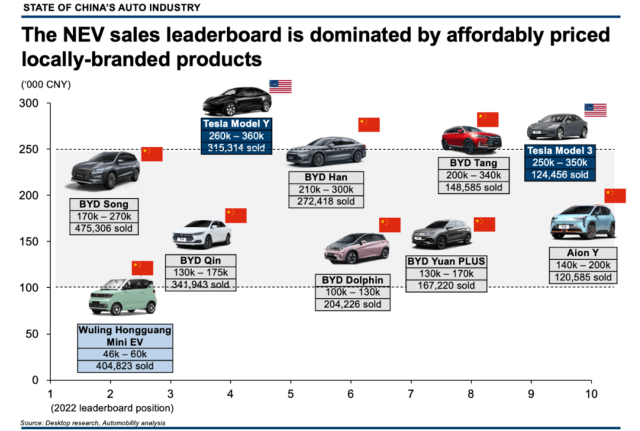The Chinese Automotive Market: Opportunities And Obstacles For Brands Like BMW And Porsche

Table of Contents
Opportunities in the Chinese Automotive Market
Booming Demand for Luxury Vehicles
China's burgeoning middle class is a significant driver of the demand for luxury vehicles. Rising disposable incomes are directly translating into increased spending on premium goods, with automobiles representing a key status symbol. The preference for established European brands like BMW and Porsche remains remarkably strong, fueled by perceptions of quality, prestige, and technological advancement.
- Growth in high-income households: The number of Chinese households with significant disposable income is steadily increasing, creating a larger pool of potential luxury car buyers.
- Increasing brand awareness of luxury vehicles: Extensive marketing campaigns and the aspirational nature of luxury car ownership have increased brand awareness amongst the target demographic.
- Strong consumer confidence in specific brands: Established brands like BMW and Porsche enjoy a strong reputation for reliability and performance, fostering consumer trust and loyalty.
Government Support and Infrastructure Development
The Chinese government actively promotes the adoption of electric vehicles (EVs) through various initiatives. This presents a significant opportunity for luxury brands to showcase their electric vehicle offerings and tap into a rapidly growing segment of the market. Simultaneously, substantial investments in charging infrastructure are making EV ownership increasingly convenient. Furthermore, the continued development of robust transportation networks enhances accessibility to even the most remote areas.
- Government subsidies for EVs: Government incentives and subsidies make electric luxury vehicles more affordable and attractive to consumers.
- Expansion of charging station networks: The rapid expansion of charging infrastructure is addressing range anxiety, a major concern for potential EV buyers.
- Investment in road and rail infrastructure: Improvements in road networks and high-speed rail facilitate easier travel and access to dealerships and service centers across the country.
E-commerce and Digital Marketing Opportunities
The prevalence of e-commerce in China presents a unique opportunity for luxury brands. Online platforms like Alibaba and JD.com offer unparalleled access to a vast consumer base, allowing for targeted digital marketing campaigns and personalized experiences. Data-driven insights enable the creation of highly effective marketing strategies tailored to specific demographics and consumer preferences.
- Alibaba and other e-commerce giants: Leveraging these platforms for sales and marketing allows for direct engagement with potential customers.
- Use of social media for marketing: Social media platforms like WeChat are crucial for reaching and engaging with the target audience in China.
- Data analytics for consumer segmentation: Analyzing vast amounts of consumer data allows for highly targeted marketing campaigns that maximize ROI.
Obstacles in the Chinese Automotive Market
Intense Competition
The Chinese automotive market is characterized by fierce competition. Domestic Chinese brands are rapidly gaining market share, challenging established international players with innovative products and aggressive pricing strategies. Foreign brands must adapt to these local preferences and compete effectively to maintain their market position.
- Rise of domestic brands like Nio and Xpeng: These homegrown brands are leveraging technological advancements and appealing designs to compete with established international players.
- Price wars among competitors: The intense competition often leads to price wars, impacting profitability and requiring strategic pricing adjustments.
- Need for localized product development: Tailoring vehicles to meet specific Chinese consumer preferences and regulatory requirements is crucial for success.
Regulatory Hurdles and Trade Policies
Navigating the complex regulatory landscape in China presents a significant challenge. Import tariffs, stringent emissions standards, and localization requirements demand significant investment and expertise. Adapting to the ever-evolving regulatory environment is crucial for long-term success.
- Import duties and taxes: High import duties and taxes increase the cost of importing vehicles and components into China.
- Stringent emissions standards: Meeting increasingly stringent emissions standards requires significant investment in research and development.
- Localization requirements: The government often mandates a certain level of local production, requiring investment in local manufacturing facilities.
Cultural and Consumer Preferences
Understanding Chinese consumer preferences and cultural nuances is paramount. Marketing strategies must be meticulously tailored to resonate with local tastes and values. Adapting to unique consumer behaviors and expectations is essential for fostering customer loyalty and building brand recognition.
- Preference for certain vehicle features: Chinese consumers often have specific preferences for features and functionalities that may differ from those in other markets.
- Social status associated with car ownership: Car ownership often carries significant social status in China, influencing purchasing decisions.
- Different approaches to customer service: Understanding and adapting to unique Chinese expectations regarding customer service is critical for positive brand perception.
Conclusion
The Chinese automotive market offers a complex duality: massive potential juxtaposed with considerable hurdles. The surging demand for luxury cars and supportive government policies create significant opportunities for brands like BMW and Porsche. However, intense competition, regulatory challenges, and the necessity of understanding deeply ingrained cultural preferences present substantial obstacles. Success hinges on a strategic approach that balances aggressive market penetration with a profound understanding of the local context. To thrive in the Chinese automotive market, brands must embrace innovation, adapt to local preferences, and skillfully navigate the regulatory landscape. Invest in a thorough understanding of the China car market; the potential rewards are significant. Don't overlook the opportunities within this dynamic automotive market in China.

Featured Posts
-
 Analyzing The Expansion Of Canadas Top Natural Gas Producer
May 11, 2025
Analyzing The Expansion Of Canadas Top Natural Gas Producer
May 11, 2025 -
 Ipswich Town Women Aim For Top Spot Gwalia Match Preview
May 11, 2025
Ipswich Town Women Aim For Top Spot Gwalia Match Preview
May 11, 2025 -
 Two Celtics Players Unexpectedly Drop 40 Points Each
May 11, 2025
Two Celtics Players Unexpectedly Drop 40 Points Each
May 11, 2025 -
 Potential Successors Exploring The Field Of Papal Candidates
May 11, 2025
Potential Successors Exploring The Field Of Papal Candidates
May 11, 2025 -
 Sorteo Campeonato Uruguayo Segunda Division 2025 Cuando Comienza La Temporada
May 11, 2025
Sorteo Campeonato Uruguayo Segunda Division 2025 Cuando Comienza La Temporada
May 11, 2025
